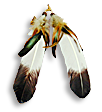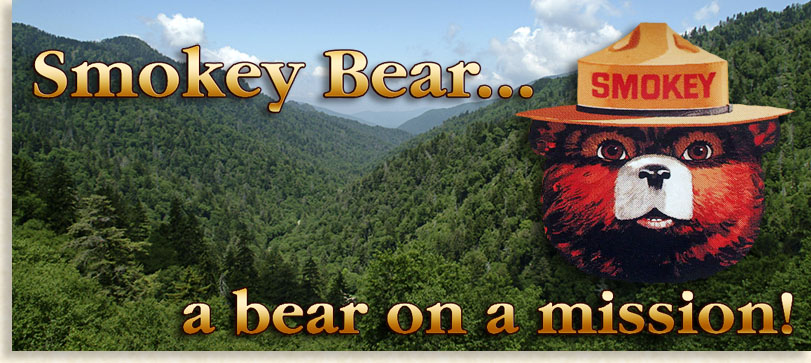
Smokey Bear...a bear on a mission
Reminding People to be Careful When They Use Fire
“In the year of 2008 CE, the United States experienced 8,856 wildfires burning 1,862,477-acres that were caused by an Act of Nature or natural order attributed to lightning strikes. Also in 2008 there were 70,093 wildfires caused by human activities burning 3,429,991-acres throughout the intercontinental US. An amazing fact to consider is that 58% of human caused wildfires and 58% of acres burned from human caused fires were located in the South and Southeastern United States.”

Growing up I remember three great symbols that represented the spirit of the United States of America. The majestic bald eagle descending from the heavens with wings pulled back, head looking downward and talons spread wide open. Then there was that intimidating portrait of Uncle Sam in his big top hat and clothing styled after the colors of our nation’s flag, along with that commanding finger of his pointing directly at me I thought declaring “Uncle Sam Wants You.” “Wants Me,” I was just a little guy at the time, being a semi-dedicated Boy Scout was more than I could handle, my scoutmaster and Uncle Sam were both stern and demanding leaders and acted as though they both had the same mother, a woman I didn’t necessarily want to meet. Then there was that lovable Smokey Bear with his kind eyes, adorable smile and gentle demeanor. His low fatherly voice bellowed from the TV screen in those early days of television declaring that, “Only You (I) can prevent forest fires.” This was quite another tall order for a little guy who grew up in “the” major mid-western city. I took my orders from Smokey very seriously considering there were only three sizable trees on the property of the apartment building where my family lived.
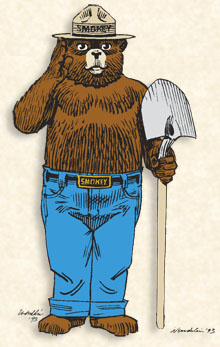 I viewed the image of Smokey Bear with the same affections I had toward my favorite animated characters, but without all the sight gags and violent mishaps they endured. Smokey Bear was special, his strong proud stance and that handy shovel he carried showed he was always ready for the call of duty along with wearing that incredible “ranger hat” that crowned his mighty head, signifying order and responsibility to his audience. Plus Smokey always wore trousers that were most fitting to his upright “big bear “dignity. It always bothered me that “Porky the Pig” never wore pants, and then there was that curly tail hanging out from under the back of his coat and those cloven feet, all of which would kind of creep me out, the character moved about like he was walking in hoof heels. I did find the stammer in Porky’s speech to be sweet and endearing, plus he was often more intelligent than his fellow cartoon companions. I can only imagine what Porky the Pig could have become if he just put some pants on or even shorts for that matter.
I viewed the image of Smokey Bear with the same affections I had toward my favorite animated characters, but without all the sight gags and violent mishaps they endured. Smokey Bear was special, his strong proud stance and that handy shovel he carried showed he was always ready for the call of duty along with wearing that incredible “ranger hat” that crowned his mighty head, signifying order and responsibility to his audience. Plus Smokey always wore trousers that were most fitting to his upright “big bear “dignity. It always bothered me that “Porky the Pig” never wore pants, and then there was that curly tail hanging out from under the back of his coat and those cloven feet, all of which would kind of creep me out, the character moved about like he was walking in hoof heels. I did find the stammer in Porky’s speech to be sweet and endearing, plus he was often more intelligent than his fellow cartoon companions. I can only imagine what Porky the Pig could have become if he just put some pants on or even shorts for that matter.
My concern for Smokey Bear is that his symbol as a national icon in our present times might have a reduced impact on today’s children. Too many of our children have lost interest in the lovable responsible kind of characters from our yesterdays (like some of the animated heroic Disney characters) due to their distraction by high tech toys and lack of greater exposure for this most important “big bear” of the forest.
In those early days public service messages had only three network channels to deal with instead the over 200-plus channels on satellite and/or cable broadcasting. Personally I feel as though good ole’ Smokey has less public visibility than in my early days, although he still can be found conveying his message on rural billboards, magazine ads, some television spots and other communication mediums.
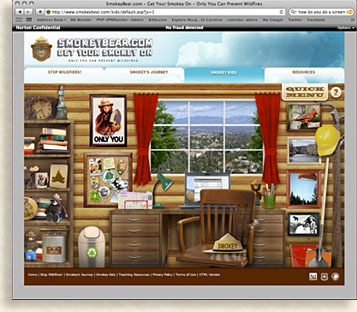 Smokey Bear does have a lovely permanent home on the Internet at SmokeyBear.com; a great site for kids and adults alike where you can gain greater knowledge of his mission and his history as an American Icon and “Guardian of the Forest” The site presents his personal interactive cabin with informative features, games and educational materials. Smokeybear.com features the latest public service ads, has an area to learn about wildfires and how to prevent them, and an area to view and listen to historic prevention public service ads, posters, radio ads; and a kid’s area.
Smokey Bear does have a lovely permanent home on the Internet at SmokeyBear.com; a great site for kids and adults alike where you can gain greater knowledge of his mission and his history as an American Icon and “Guardian of the Forest” The site presents his personal interactive cabin with informative features, games and educational materials. Smokeybear.com features the latest public service ads, has an area to learn about wildfires and how to prevent them, and an area to view and listen to historic prevention public service ads, posters, radio ads; and a kid’s area.
The year 2009 marks the 65th birthday/anniversary of this great American Icon and his persistent message regarding Fire Safety and Prevention.
As one of the world’s most recognizable fictional characters, Smokey’s image and name is protected by U.S. Federal Law and is administered by the USDA Forest Service in cooperation with the National Association of State Foresters and the Ad Council. "Permission was granted by the USDA Forest Service for the Smokey images within this story."
The Smokey Bear Wildfire Prevention campaign, created in 1944 is the longest running public service advertising campaign in U.S. History.
In 1944 the campaign began with the catch phrase, “Smokey Says…Care Will Prevent 9 out of 10 Forest Fires.”
In 1947 it was changed to “Remember…Only YOU Can Prevent Forest Fires.”
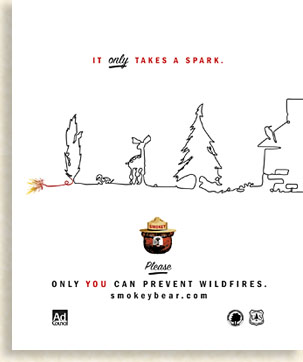 In 2001 the new 21st century campaign began with a modified slogan, “Only You Can Prevent Wildfires.” The change came in response to a massive outbreak of wildfires in natural areas other than forest. The Term ‘wildfire” applies to any unwanted, unplanned, uncontrolled outdoor fire.
In 2001 the new 21st century campaign began with a modified slogan, “Only You Can Prevent Wildfires.” The change came in response to a massive outbreak of wildfires in natural areas other than forest. The Term ‘wildfire” applies to any unwanted, unplanned, uncontrolled outdoor fire.
Even today, irresponsible actions by humans cause 9 out of 10 wildfires. With millions of U.S. acres of wild and wooded lands, being burned each year, the symbolic image of Smokey Bear helps bring an acute awareness to this devastating force whether it was caused naturally, unintentionally or deliberately.
This wise and friendly bear icon has had a great impact on both adults and children alike and thanks to this long running campaign our children, like ourselves will continue to grow up with this ageless symbol of safety, prevention and awareness. Smokey Bear’s message is as relevant today as it was in 1944 and has spun off into many other important fire prevention programs.
First, I would like to make note that there is no “the Bear” in Smokey’s name, its just Smokey Bear, a title name given and not a description. The “the” came about in 1952 when two song writers, Jack Rollins and Steve Nelson, wrote a song for Smokey and the music had an extra note in it, so the song writers added a ‘the’ to Smokey Bear.
A boost to the “legendary” Smokey Bear originated in New Mexico several years after the fire prevention campaign first began, a true tale that is both exciting, disastrous and heart felt. Rather than focusing on the character, the facts and fiction of his life’s legacy, this feature Blue Ridge Highlander story will first cover the true tale of his transformation from innocent bear cub to a big bear hero…and the story goes:
THE TRUE STORY OF (little) SMOKEY BEAR
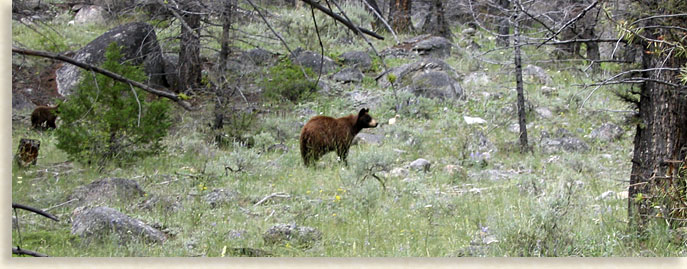
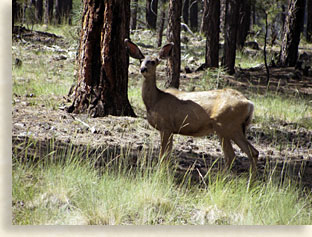 It all began in the Captain Mountains on an unseasonably hot day in May of 1950 in the Lincoln National Forest, New Mexico. All the animals of the forest were quietly resting in the shade in order to ward off the heat of the day; the cool waters of stream banks offered shelter to the swimming trout from the blazing rays of the sun. A little brownish colored black bear cub undaunted by the heat played about the grounds while his mother dozed under the shade of a large rock. The unexpected Spring heat and drought burnt the green grass of the meadows brown as the cool waters of the streams became lower and lower with each passing day. All the elements of the forest became dry and brittle; a tinderbox of pine needles, broken branches and twigs.
It all began in the Captain Mountains on an unseasonably hot day in May of 1950 in the Lincoln National Forest, New Mexico. All the animals of the forest were quietly resting in the shade in order to ward off the heat of the day; the cool waters of stream banks offered shelter to the swimming trout from the blazing rays of the sun. A little brownish colored black bear cub undaunted by the heat played about the grounds while his mother dozed under the shade of a large rock. The unexpected Spring heat and drought burnt the green grass of the meadows brown as the cool waters of the streams became lower and lower with each passing day. All the elements of the forest became dry and brittle; a tinderbox of pine needles, broken branches and twigs.
Hot dry winds began to blow throughout this region of New Mexico that spring day; the Lincoln National Forest had become ripe and ready for a most unfortunate occurrence. There was no precipitation or lightning that day, so a natural disaster was ruled out when the fire suddenly occurred.
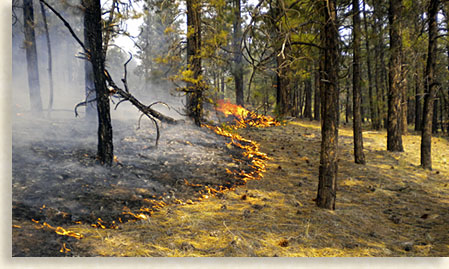 With no given warning it just happened, it only took one careless person who either left their camp fire unattended, or maybe tossed down a match that wasn’t properly extinguished, or possibly a smoking cigarette found its way into the dry brush. Whatever the cause, a blaze took hold that quickly grew out of control driven by strong dry winds with dry underbrush and dry grasses accelerating the blaze from one tree to another. Before anyone knew it, a roaring forest fire began to eat the landscape of the national forest threatening the wildlife inhabitants of this wilderness community.
With no given warning it just happened, it only took one careless person who either left their camp fire unattended, or maybe tossed down a match that wasn’t properly extinguished, or possibly a smoking cigarette found its way into the dry brush. Whatever the cause, a blaze took hold that quickly grew out of control driven by strong dry winds with dry underbrush and dry grasses accelerating the blaze from one tree to another. Before anyone knew it, a roaring forest fire began to eat the landscape of the national forest threatening the wildlife inhabitants of this wilderness community.
A sharp-eyed observer high atop a lookout tower spotted the distant rising clouds of smoke from the growing inferno. Immediately he contacted the ranger station pinpointing the area of danger on Captain Mountain. Firefighters grabbed their helmets and firefighting tools as they mounted their heavy equipment and rushed to the scene of the blazing fire.
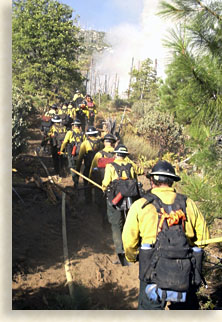 They worked their way up steep mountain slopes, clearing trees creating a pathway to the isolated region of the threatening fire. Arriving within sight of the blaze they began to use their shovels, axes and bulldozers to dig, cut and plow wide fire-lines, attempting to stop or turn back the rushing blaze. These dedicated and professional forest firefighters played by the book creating a barrier between the threat before them and the safety of the forest and wild-lands behind them, yet it was to no avail for some of the firefighting crews.
They worked their way up steep mountain slopes, clearing trees creating a pathway to the isolated region of the threatening fire. Arriving within sight of the blaze they began to use their shovels, axes and bulldozers to dig, cut and plow wide fire-lines, attempting to stop or turn back the rushing blaze. These dedicated and professional forest firefighters played by the book creating a barrier between the threat before them and the safety of the forest and wild-lands behind them, yet it was to no avail for some of the firefighting crews.
Strong winds drove burning brush across the fire-line igniting the dry forest behind them they were fighting to save.
The animals of the forest began to panic with fright as the fiery blaze devoured their forest. Trying to flee from the blaze many of the animals became disorientated by the smoke and heat and unfortunately ran directly into the fire tragically ending their cherished lives. Many of the other animals ran in the right direction towards safety but were overtaken by a blaze that could out run the fastest deer or cougar.
The forest fire was overwhelming the firefighters as more men were called into action. Local woodsmen, ranchers, and Tribal members joined in to help but it was not enough. Soldiers from Fort Bliss and Texas were called to duty to help contain the blaze all joining together along the fire-lines in hopes of driving the fire backwards. Scores of brave firefighters were fighting the blaze side by side hoping to save an entire forest from the misdeeds of one careless and irresponsible person.
In one section of the national forest, a group of twenty-four firefighters were ordered to battle the blaze. Here they were fighting to stop a ground blaze in front of them by building a fire-line or break around it. They were not just fighting a threatening fire they were soon to become victims of a force as great as the fire itself, the wind.
The scorched and dry earth along with strong uncontrollable winds that drove the fire demanded constant compensation from the life of the forest and the firefighters themselves who stood in its destructed path. The raw elements of the forest were now against them; forty mile-an-hour winds were feeding the flames, as the firefighters saw their own mortality no different than the wildlife that had been consumed by the ferocious flames. Suddenly the blaze jumped from the grass and underbrush into the trees and rushed towards them with flames so hot their work became unbearable. Fighting the wildfire became impossible to continue, let alone stop. Their only hope was to hurry to the confines of a rock-slide as they had been trained to do under such extreme circumstances providing one was available.
Reaching the rock-slide they climbed in amongst the rocks and laid face down between the boulders. The flames weren’t the only threat to their lives; the heat and smoke were just as deadly as the blazes themselves. Relying on their training they tied handkerchiefs over their faces to keep from smothering and lay together in order to support their fellow comrades.
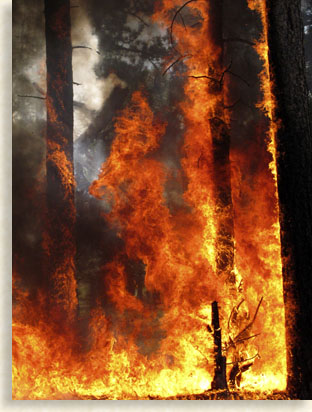 The heat was so intense some of the firefighter’s clothing would burst into flames as they helped each other put them out by hand. Together they clung side by side braving out the intense heat of the inferno, deafened by the roar of the fire they laid in silence as they held on to their faith, praying to the divine to spare their lives and deliver them from this hell on earth experience. Minutes must have seemed like eternity, seconds were the only fire-line now dividing life and death when all of a sudden after about an hour’s time, their prayers were answered as the raging fire broke and they were freed from this chamber of horror.
The heat was so intense some of the firefighter’s clothing would burst into flames as they helped each other put them out by hand. Together they clung side by side braving out the intense heat of the inferno, deafened by the roar of the fire they laid in silence as they held on to their faith, praying to the divine to spare their lives and deliver them from this hell on earth experience. Minutes must have seemed like eternity, seconds were the only fire-line now dividing life and death when all of a sudden after about an hour’s time, their prayers were answered as the raging fire broke and they were freed from this chamber of horror.
As the smoke cleared heads began to raise, one at a time the firefighters rose from the safety of their rock sanctuary. One…two…three…four, all twenty-four men accounted for, a miracle indeed.
Gathering their senses and whatever they might have carried to their stronghold of temporary safety, the men looked around contemplating their ordeal, the burnt remains of the forest and the grounds all around them. Suddenly they noticed something that seemed out of place. There, tightly gripping to a charred tree limb was a terrified and badly burned little cub bear shaking with fright and in pain. The firefighters carefully took hold of him and helped him down from the limb. They carried the little cub in their arms through the charred and smoldering remains of the forest, past streams filled with debris and wood ash, if the heat didn’t kill the fish surely the contaminated waters did.
What was once a pristine forest was now burnt and twisted beyond recognition. This place of refuge was once the only home the cub knew; now the forest and surrounding wild-lands harbored no wildlife at all. The landscape was laid to waste, it was likely that the cub’s mother along with countless other animals died in the flames by the evidence of the many bodies the firefighters encounter along their journey back to safety, all due to one careless person’s lack of respect for life itself.
The forest fire burnt for 5-days before it was finally brought under control by the brave souls who put their life on the line in order to contain a blaze that could have lasted for weeks. A spark that grew into a firestorm destroyed over 17,000-acres of the Lincoln National Forest and grasslands. Along with the forest and wild-lands, the natural watershed and its ability to store water in its lakes and ponds were badly damaged as well as polluted by the abundance of ash. The wildlife habits that had endured for generations where gone. The beauty and recreational benefits for visitors to this region of Lincoln National Forest were burned out.
Back in safe haven the poor, little; bear cub was treated for his wounds and burns by a veterinarian and assisted by wardens from the New Mexico Game and Fish Department. The cub’s feet were all bandaged looking as if he were wearing stockings while the ranger’s spoon-fed him baby food until he was strong enough to partake in a more natural bear diet. His burns and wounds healed quickly under their loving care, even his fur grew back. Most everyone who encountered him fell in love with the innocent little bundle of fur, especially a ranger’s wife and daughter. It was not such a love between the rangers and the cub bear, the cub had sharp teeth and bit the rangers an awful lot. The little cub might have felt more comfortable with the females of our species.
Yet in spite of the cubs dental attributes the rangers became so fond of the little cub they named him “Smokey,” after his ordeal and adjoin the little bear with the present symbol of the Forest Fire Prevention campaign.
A Few Bear Facts…when a bear is removed from its familiar surrounding they will persistently try to return to their home habitat.
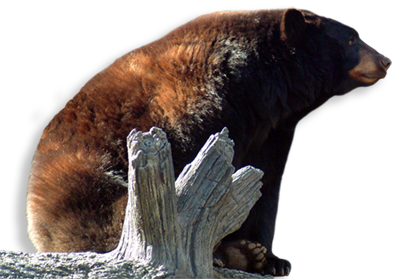
A little bear cub cannot survive without their mother’s nourishing care until they become a yearling at the age of 18-months.
Any bear cub found abandoned should be reported to the local Wildlife Agency immediately. Do not attempt to rescue the cub yourself, a mama bear may likely be close by, therefore do not consider the cub to be an orphan just yet.
Without a natural mother, healthy cubs must be properly cared for in order to return them safely to the wilds one day, bears with disabilities must be placed in zoos or other proper facilities, unfortunately the wild can no longer be their home.
For more information concerning the welfare of abandoned cubs in the Blue Ridge Smoky Mountain regions see Blue Ridge Highlander’s feature story Appalachian Bear Rescue and Bear Safety along with other black bear featured stories. ABR is dedicated to the care of unfortunate bear cubs needing their help.
Now Back to the Story…
With no home to return to, it was decided by the New Mexico Game and Fish Department to fly little Smokey to our nation’s capital in Washington D.C. where he became an instant celebrity at the airport greeted by a crowd of people, reporters and photographers. The little cub that miraculously survived the forest fire was now known as Smokey Bear, the kids loved him and the adults adored him and admired his innocent bravery. While under the guardianship of the USDA Forest Service a ranger decided to put a Forest Ranger’s big brimmed hat on little Smokey while he posed for some posters for the Forest and Wildfire Prevention campaign. The posters were a big hit and spread across the nation for everyone to see the latest and one of the bravest members of our nation’s national Forest Service. Everyone heard his harrowing tale on the radio or saw him on television.
Without a mother to teach him the ways of the wild, he was given a home in the Washington Zoo so that all of his fans could come and visit him. As he grew, so did the unyielding symbolic Smoky Bear icon, the protector of the forest telling folks about the dangers of forest and wildfires.
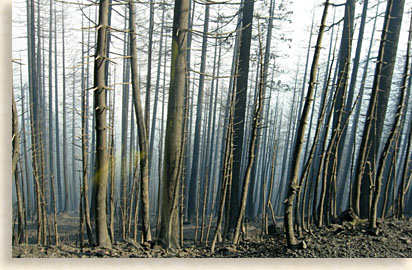 Forest Fires devastate wildlife and their habitats as well as people and their homes. It destroys lumber meant for construction, furnishings, paper meant for education, books and newspapers as well as many other uses. Wild Fires pollute the natural water supply and puts harmful ash particles in the air we breathe. It scorches the grass that feeds grazing animals. It puts the lives of forest firefighters, rangers and wildlife, as well as all those who assist them along with the visitors who frequent our natural and wild areas in mortal danger.
Forest Fires devastate wildlife and their habitats as well as people and their homes. It destroys lumber meant for construction, furnishings, paper meant for education, books and newspapers as well as many other uses. Wild Fires pollute the natural water supply and puts harmful ash particles in the air we breathe. It scorches the grass that feeds grazing animals. It puts the lives of forest firefighters, rangers and wildlife, as well as all those who assist them along with the visitors who frequent our natural and wild areas in mortal danger.
The heroic Smokey Bear lived at the Washington Zoo enjoying the good bear life as a national celebrity until 1976, his legacy lives on.
The symbol of Smokey Bear and his courageous tale reminds us to be responsible for our actions when enjoying the beauty and wonders of our forests and wild-lands by; making sure to only discard our matches after they have cooled; that every camper safely put out their camp fires and charcoal fires; to extinguish completely any and all tobacco and other products that might produce a flame or amber, and never leave a debris fire unattended. Always consider all the possibilities that might create a wildfire that may not only destroy a forest, it may also take your own life and others. A night campfire unattended can overwhelm sleeping campers before they can even react. And for you little ones who like to play with matches, fire is not a toy it’s a dangerous tool in the wrong hands.
Together we have all grown up with our beloved Smokey Bear and know him as the hardest working Prevention of Wildfire’s bear in the nation. His symbol stands as a call for taking personal responsibility in our own lives in regards to all fire prevention. His image continues to bear that gentle look of concern, whose head is crowned with that regal ranger hat signifying him as “guardian of the forest.”
Facts and Misperceptions of Smokey Bear
Though the fire prevention campaign officially began in 1944, the “legendary Smokey” public image really got the ball rolling in 1950 after the New Mexico wildfire. The vision of a national fire prevention program though started in the spring of 1942 during World War II. An enemy submarine fired several shells into and oil refinery near the Los Padres National Forest; it was an attack on our nation’s vital natural resources. From this growing concern the Wartime Advertising Council, the Association of State Foresters, and the US Forest Service combined forces to create the Cooperative Forest Fire Prevention (CFFP) Program. On August 9, 1944 the Smokey Bear campaign was launched. The bear’s original image was painted by Albert Staehle. In later year’s, the image was helped along by artist Rudolph Wendelin.
Before the idea of using a bear was thought of, the Walt Disney motion picture, “Bambi” was released. Disney lent the Forest Fire Prevention campaign the use of his creation on a poster for one year. This was a great promotion for the campaign and excellent movie exposure for Disney. Today, many fire prevention billboards display several forest characters along with Smokey himself offering its important message, “Only You Can Prevent Wildfires.”
On a personal note, I wasn’t born until a few years after the New Mexico, Smokey Bear wildfire story and then there was that basic learning curb I went thru for a couple of years in order to have some minor understanding of the English language that I missed the big hoopla of “little” Smokey’s big adventure.
 One of my personal misperceptions concerning Smokey Bear is that the fire prevention icon obtained his title from America’s most visited national park, the Great Smoky Mountains National Park. I thought the only difference was our fire prevention bear was using the correct spelling for the word “Smokey.” I was wrong, no connection, they were both separate entities.
One of my personal misperceptions concerning Smokey Bear is that the fire prevention icon obtained his title from America’s most visited national park, the Great Smoky Mountains National Park. I thought the only difference was our fire prevention bear was using the correct spelling for the word “Smokey.” I was wrong, no connection, they were both separate entities.
It is popularly assumed (not a fact) that Smokey drew his name from his earliest origins after “Smokey” Joe Martin the assistant Chief of the New York City Fire Department.
Though Smokey is a brownish colored bear he is of the black bear species that is commonly found in the Great Smoky Mountains as well as most wilderness area of the continental United States. Black bear’s colors range from black, blue black, brown, cinnamon, blonde, blue gray glacier and a rare white that was thought to have great spiritual significance to the Cherokee.
Another misperception of mine along with many others is that there is no “the” in his titled name. In 1952 due to Smokey’s growing popularity Steve Nelson and Jack Rollins wrote an anthem for Smokey and added the word “the” to his name to balance the tunes rhythm.
One more fact, I’m going to go out on a limb here when I say I’m pretty confident that our nations State Police or Troopers got that title of being called “Smokey’s” from our beloved Smokey Bear’s Ranger Hat.
The Campaign Carries On
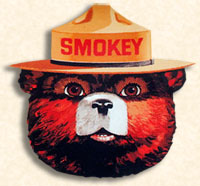 August 9, 2009 celebrates the 65th birthday/anniversary of Smokey Bear, a legacy that is fighting the good fight against wildfires. This is not an endless bureaucratic campaign that has allowed dust to gather upon its purpose, it’s a campaign dedicated to survival and prevention and is allotted no days off for good service. Fire is a threat to all that lives and grows; awareness and prevention is the most effective defense against wildfires.
August 9, 2009 celebrates the 65th birthday/anniversary of Smokey Bear, a legacy that is fighting the good fight against wildfires. This is not an endless bureaucratic campaign that has allowed dust to gather upon its purpose, it’s a campaign dedicated to survival and prevention and is allotted no days off for good service. Fire is a threat to all that lives and grows; awareness and prevention is the most effective defense against wildfires.
Foot, Cone and Belding, now called Draftfcb, is the volunteer advertising agency responsible for developing the creative work for the campaign while carrying on the duty into its third generation of producers, credited with maintaining the longest running, most successful public service campaign in the nation.
Smokey Bear has an expanding presence and message on the world wide Internet. Educational materials are available for download on SmokyBear.com.
On the site you’ll find outlines for wildfire lesson plan grades K-5, along with a Smokey Bear Activity Book with wildfire-learning materials, a full-color Smokey Bear Kid’s Poster and other materials concerning wildfires. These activities include children designing their own Smokey Bear wildfire prevention poster. After completion of the booklet the children that send in the enclosed postcard will receive a badge and certificate. Fire prevention games, the Smokey Bear song and downloads of coloring sheets are also available on-line.
It’s our children who will inherit our national treasures, resources and wild-lands, they are the ones who will be responsible for carrying on a tradition of wildfire prevention and safety program just as we have over the last several decades. Educating our children as the program does assures a responsible attitude towards wildfire prevention, young awareness will continue into adult awareness.
The Smokey Bear Program makes available the big bear himself for visits to classrooms and children’s groups, if you are interested call local your local state forester office or a national forest near you to check availability. Upon his visits Smokey will share with the class a short Wildfire Prevention Program presented by a uniformed employee.
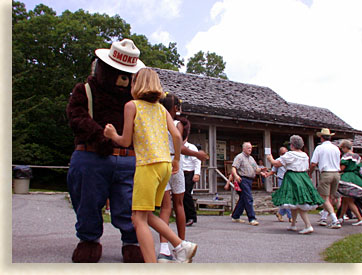 Smokey only makes personal appearances for events that feature or include a wildfire prevention theme. Being a protected national treasure in his own right, there are guidelines for his personal appearances that must be acknowledged.
Smokey only makes personal appearances for events that feature or include a wildfire prevention theme. Being a protected national treasure in his own right, there are guidelines for his personal appearances that must be acknowledged.
SmokeyBear.com also offers a history of Smokey’s specialized wildfire prevention and safety campaign since it began in 1944 to present day as well as a visit to Smokey’s personal on-line cabin. It’s a fun and informative site for kids of all ages. This dedicated public service towards wildfire prevention and safety comes to you courtesy of the USDA Forest Service, the National Association of State Foresters, and the Ad Council - your tax dollars doing good work. In 1952 an Act of Congress passed to take Smokey Bear out of public domain and place him under the control of the Secretary of Agriculture protecting the trademark. This also protect us taxes payers, the actual owners of the Smoky Bear “intellectual properties” from being exploited by some for personal gain.
Wildfire Prevention and Safety
Wildfire experts understand that most human caused wildfires are started unintentionally, an accident that can have devastating results. A fire can quickly get out of control especially when all the surrounding elements are prime for conditions. With of without intention, wildfires happen due to carelessness more than any other act or natural cause. Wildfires result in destroyed wild-lands and forest, private property, homes and can devastate millions of acres of natural resources and agricultural goods as well as human and wild life. It destroys young trees as well as old growth forests that are hundreds of years old, mostly due to carelessness.
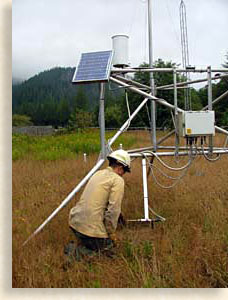 Fire has been a useful tool to mankind since the beginning of known time. It gives us warmth, cooks our food, breaks down and reforms matter, and is the predecessor of the illumination we need to lighten darken periods or unlit interiors. It is also by far one of the greatest destructive powers of nature when improperly handled.
Fire has been a useful tool to mankind since the beginning of known time. It gives us warmth, cooks our food, breaks down and reforms matter, and is the predecessor of the illumination we need to lighten darken periods or unlit interiors. It is also by far one of the greatest destructive powers of nature when improperly handled.
We use fire as a tool knowing it is capable of good as well as evil. Normal functions such as leaf burning, debris stacks or barrel burning along with large burn piles can be the makings of a possible wildfire. These acts are considered illegal in some areas of the nation. Any unattended burning increases the potential for wildfires. Poorly maintained or careless use of ATV’s or power equipment old or new, campfires, discarded smoking items, children or adults entertaining themselves with matches or lighters and especially free-wheeling use of legal or illegal fireworks are an open door to a possible wildfire.
We’ve all experience some kind of unintentional fire mishap in our personal lives, there’s always a story to tell and if you don’t want to confess your own experience you can choose a friend or family member as a witness to the foolish use of fire. With that in mind I’ll relate an incident involving a person I’ll call “mom’ since she’s probably not listening anyway.
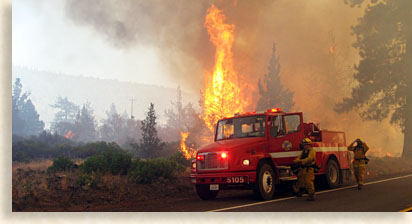 Mom lives in rural western Kentucky just outside a little town whose claim to fame is that the Jesse James Gang robbed their town bank once. It was such a memorable occasion that they painted a giant artist rendition of the robbery on the lobby wall of the bank, need I say more. Now back to mom, just outside of town living in a modest neighborhood surrounded by open fields and wooded hills, mom often burned some of her garbage in a barrel in the back of her one-acre property, she knew from her rural upbringing to keep fire away from the house, plus it might make something dirty. Now she had garbage service yet dad who passed away many moons ago also burnt trash in a barrel and I guess she just wanted to carry on the tradition. After several years of her “rural cowgirl barrel burning exploits,” mom’s luck ran out when she unintentionally set the neighboring field on fire. Fortunately she lived just outside the city limits and a fire crew rushed right to the scene.
Mom lives in rural western Kentucky just outside a little town whose claim to fame is that the Jesse James Gang robbed their town bank once. It was such a memorable occasion that they painted a giant artist rendition of the robbery on the lobby wall of the bank, need I say more. Now back to mom, just outside of town living in a modest neighborhood surrounded by open fields and wooded hills, mom often burned some of her garbage in a barrel in the back of her one-acre property, she knew from her rural upbringing to keep fire away from the house, plus it might make something dirty. Now she had garbage service yet dad who passed away many moons ago also burnt trash in a barrel and I guess she just wanted to carry on the tradition. After several years of her “rural cowgirl barrel burning exploits,” mom’s luck ran out when she unintentionally set the neighboring field on fire. Fortunately she lived just outside the city limits and a fire crew rushed right to the scene.
Wildfires can race across an open field with or without wind assistance. This could have been a major catastrophe had the fire crew not arrived so quickly. Mom was grateful for their speedy and courageous help and not so happy about the fine and bill the Fire Department sent her. The good news, she doesn’t burn trash anymore. For the record, dad was so conservative and cautious I can’t remember any type of fire instance in our lifetime together, he was somewhat Smokey Bear like.
Fire prevention isn’t something you learn on the job, fire prevention is premeditated by understanding the proper means of handling a potentially dangerous tool…fire. Unfortunately 76% of southern wildfires are caused by human error with 38% coming directly from “debris burning” and 23% from deliberate woods arson. The remaining 39% of human cause comes from children playing with matches, unattended campfires and cigarettes; all these wildfires could have been avoided with proper safety precautions.
At USDA Forest Service’s www.clioconcepts.com/fire/ you’ll find a helpful inter-agency wild-land fire incident information management system. The site was designed for homeowners, visitors, wildfire prevention professionals, Forest Service employees and volunteers. There’s updated information on the location of big wildfires that are burning throughout our nation. Also included is information on the severity levels in your state with rules and regulations for debris burning and how to protect your home against wildfire. Educational materials are available in the area of fire prevention.
Nationwide, 9 out of 10 wildfires are avoidable when proper care is taken and foolish behavior is sidelined. Accidents can happen yet they are a poor excuse for the destruction wildfires cause. Smokey Bear, the image we are so familiar with tells us danger is always at hand, and Smokey has been telling it straight for decades that “Only Your Can Prevent Wildfires.”
Now’s a good time for you to “Get Your Smokey On” with a wildfire prevention pledge by reciting the oath below, or if you prefer to make it official you can go to SmokeyBear.com and take the pledge on Smokey's website.
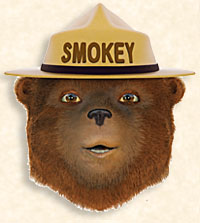
“I pledge to be smart whenever I go outdoors. To use caution and common sense before lighting any fire. To understand that any fire I or my friends create could become a wildfire. To understand and practice proper guidelines whenever I or my friends create a fire outdoors. To never, ever leave any fire unattended. To make sure any fire that I or my friends create is properly and completely extinguish before moving on. To properly extinguish and discard of smoking materials. To be aware of my surroundings and careful when operating equipment during periods of dry or hot weather. To speak up and step in when I see someone in danger of starting a wildfire.”
Smokey Bear would be very proud of you!
The Front Line…Fighting Fire with Skill and Tools
The Real Life Smokey Bears
Some kids grow up and want to be a firefighter. Some boys and girls dream of one day becoming a Forest Ranger, the combination of both heroic firefighter and guardian of the forest and wild-lands is reflected in the image of Smokey Bear, the icon of wildfire prevention and safety. You can’t get much closer to Smokey than being a Wild-lands Firefighter or Ranger.
Every month of each year in our nation there’s a wildfire going on, some modest while other blacken the sky threatening neighboring communities. Fighting these dangers, living in hardships, separated from family, friends and loved ones, are the brave souls who defend our nation from the threats of wildfires. Not only are they protecting rural communities reducing personal loss, they are simultaneously fighting to save our natural resources and treasures. These skilled individuals have earned a reputation for being among the best in the world as wildfire fighters.
Wild-land Firefighters are not only members of an elite profession; they are part of a well-managed corps committed to service. The Crews as they are called are made up of levels, skills and ranks. When a wildfire is called in, an extensively trained and experienced Fire Manager analyzes the situation carefully to determine the best course of action, developing a suppression strategy while deciding what kind of firefighters and equipment they will need to implement. At times they may choose to allow the fire to burn when it’s ignited by a natural cause such as lightning, provided that a specific plan was previously developed detailing all the conditions under which the fire would burn safely and not cause any risks. This method can at times safely reduce the amount of natural fuel expended and doesn’t degrade the local water quality, wildlife habitat or cause risk to the public.
If firefighters and equipment are called into service the assignment usually goes to Hand Crews consisting of 20 men and women. These Hand crews are the infantry of wild-land fire forces, responsible for constructing a “fire-line” which is a strip of land cleared of flammable materials around the wildfire in order to contain them. “Fire-lines” or “Firebreaks” are meant to stop or slow down any approaching wildfire, in hopes to break the path of the fire.
Then there are the Hotshot Crews, highly skilled and specially trained in suppression tactics. Like a military Special Forces group, the Hotshot Crews are usually the first to confront wildfires when they first start. They also specialize in suppressing big fires that are most threatening along with high-risk areas.
Engine Crews contain 3 to 10 firefighters, using 250 to 750 gallons of water, and hundreds of feet of hose to directly attack wildfires. There are engines that carry special equipment to spray foam and chemicals on vegetation, homes and other structures for fire resistance.
Firefighting helicopters known as “Helitack” have specially trained Helitack Crews who are often the quickest to access wildfires in remote locations by rappelling from the helitack into the area of threat.
Smoke Jumpers are firefighters that parachute from planes into remote and inaccessible areas and are often supported by para-cargo drops of personal gear, food, water and specialized equipment to help suppress fires.
All of these specialized firefighting crews are supported by trained expert Incident Management Teams whose primary responsibility is to develop and implement strategies to suppress wildfires. The team is also responsible for providing food, equipment, transportation and other goods and services to the firefighters on the front line.
Technology of Today’s Wildfire Fighters
Sometimes the old ways are the best ways to fight a wildfire, although today we have access to advance equipment improvements made for wildfire fighting. Computer technologies, fire mapping, satellite imagery, accurate weather forecast, fire behavior modeling, improvements in aircraft, water-delivering systems, fire-retardant chemicals and firefighting clothing have greatly increased the ability to fight wildfires.
Some of the equipment used to assist wild-land firefighters are, Bulldozers and Tractor Plows for clearing vegetation for fire-lines, cutting access roads to the scene of the fire. Air Tankers dump thousands of gallons of water or chemical retardants on or ahead of advancing wildfire. Helicopters carry not only crew members and supplies some are fitted with tanks or suspended buckets delivering loads, much like the air tankers. The helicopters also use the Bambi Bucket, a collapsible bucket slung below the copter in order to dip water from a variety of water sources for fire suppression.
Personal equipment for firefighters are; protective nomex pants and shirts; gloves, hard hat, goggles, face shield, and leather boots. Shovels, Pulaskis and chainsaws are the hand tools used in the job of firefighting. A drip torch is used by a firefighter when needed to light a backing fire; a fusee can also be used for this purpose. Each firefighter carries an aluminized tent, called a fire shelter, offering protection by means of reflecting radiant heat and providing a volume of breathable air if the fire traps the firefighter. Yet the most handy and effective firefighter tools are the shovels, adze hoes and the pulaski.
To rationalize this phenomenon called “wildfires” I personally realize it takes an army of firefighters and equipment the size of a forest to undo what one wild-land village idiot can do by not being responsible.
These brave firefighters put their lives on the line for our security; they are the actual firebreak between danger and safety.
Living in the Zone
Though I, like so many others have found the icon for wildfire prevention and safety both lovable and authoritative, it wasn’t until Mrs. Highlander and I relocated to the Blue Ridge Smoky Mountains 15-years ago that I personally understood the magnitude of Smokey’s vital message. Although the Southeast has more annual rainfall than the Western United States, these grand “old” mountains are still subject to many wildfires. Of the dozens of counties throughout the Blue Ridge Province approximately half of the mountain lands are either, National Forest, Park or State Parks, the rest is mostly private owned lands consisting of valleys, small mountains and forested mountain slopes.
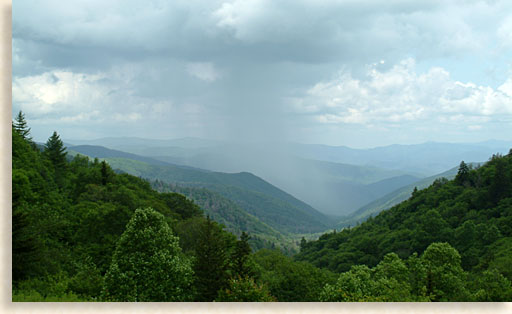 Whether the season is wet and the possibility for forest fires are low in danger, or whether it is dry and highly probable for a wildfire the threat is always there under either condition. Though Mrs. Highlander and I have rarely seen a regional forest fire we know the likely hood is always at our beckon door. Fortunately the skills of our firefighters have been outstanding in controlling or stopping wildfires.
Whether the season is wet and the possibility for forest fires are low in danger, or whether it is dry and highly probable for a wildfire the threat is always there under either condition. Though Mrs. Highlander and I have rarely seen a regional forest fire we know the likely hood is always at our beckon door. Fortunately the skills of our firefighters have been outstanding in controlling or stopping wildfires.
The greater population areas within the mountains are outside the National Forest, National and State Parks although these protected wild-lands are on the very edge of everyday mountain life. I’ve witnessed forest fires yet have never met anyone locally that has lost property due to a forest fire although I’m sure losses have occurred. As I researched information in regards to this story and have personally witnessed the mountain country’s growth, it has become obvious that homes and communities within or bordering the wilderness are more vulnerable if a wildfire is in their area. Greater care needs to be taken when building homes within a possible tinderbox by clearing all trees and brush away from the home in hopes to diverting loss or damages. Please visit www.firewise.org for ways to make your home and property fire resistant. When you live deep in the woods you’re making a personal choice to live in an area where a drought could pose a potential danger. It’s the same choice so many pioneers made settling this southern mountainous region.
Living in the mountains we can’t continually be worried about wildfires, instead we always try to be responsible. When we hear of a wildfire, we find out what’s to be known, and act accordingly as you should. The majority of wildfires we have witnessed were mostly confined to the wilderness mountain lands of the National Forest. We lived in a cabin on a mountain ridge top for 5-years with 180-degree views in the summer months and nearly 360-degree views in the winter months. One year a wildfire started on the ridge slope directly to the south, a small fire in comparison. During the day a column of smoke rose up but not enough to alter the clear skies around it, at night the column of smoke disappeared and you could see a ring of fire going up the slope and crossing the ridge, in the center of the ring was blackness with the orange yellow flames neatly along the outer edge. The firefighters where there but you couldn’t see them. Within two days the fire was out thanks to the skilled firefighters.
Another year, setting on the porch on the same ridge top a large forest fire started in the steep cove side of a huge mountain to the southwest. This was a big fire that was fought for over a week with firefighters doing everything they could to keep the spreading fire contained. The scene from our deck looked as though the distant mountain was a volcano belching out dust and debris. The fire was extinguished and thankfully, I heard of no great destruction of private property or loss of human life.
The last year that we lived on the ridge top, I heard of a forest fire that was kicking up a fuss in the National Forest about 35-miles to the southeast. For several days I saw no signs and the sky was clear until one morning I went out on the deck and what appeared to be a heavy fog obstructed any view at all. The smoke from the fire had shifted with the wind and was now covering several counties to the north and west. You know what that wonderful burning leaf smell or cozy wood burning fireplace is like, well this wasn’t it, if anything it was irritating to the eyes and throat. Once again our brave firefighters came to the rescue and the rest of the forest was saved.
Since we moved to our present home deeper in the mountains a forest fire broke out to the east of us about five miles behind the mountain we live on. Traveling along the main route to the south of the big mountain that was ablaze, the forest that was on fire looked as though it was at least 3 to possibly 5 miles in length due to the smoke we saw rising off the mountain and drifting west. Again the forest fire was contained within the wilderness thanks to these dedicated men and women who put their lives at risk.
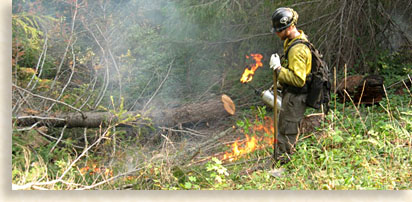 One of the ways the US Forest Service and state forestry agencies help prevent wildfires in the forest is by supervised “controlled burns.” It’s not uncommon to see burning crews out in the springtime doing controlled burns to the underbrush to alleviate the kindling that starts and spreads most wildfires. These burn specialists work in the wilderness lands in hopes to prevent future wildfires by carefully observing the actual burning and suppression of the controlled burns. Due to the immense clear-cut logging of the Southern Appalachians “old growth forests” at the turn of the 20th century, today’s younger forest has grown up over a thicket of underbrush, a perfect tinder-box for a wildfire during low rain fall averages.
One of the ways the US Forest Service and state forestry agencies help prevent wildfires in the forest is by supervised “controlled burns.” It’s not uncommon to see burning crews out in the springtime doing controlled burns to the underbrush to alleviate the kindling that starts and spreads most wildfires. These burn specialists work in the wilderness lands in hopes to prevent future wildfires by carefully observing the actual burning and suppression of the controlled burns. Due to the immense clear-cut logging of the Southern Appalachians “old growth forests” at the turn of the 20th century, today’s younger forest has grown up over a thicket of underbrush, a perfect tinder-box for a wildfire during low rain fall averages.
I left my most impressionable witnessing to a wildfire for last in this tale of Smokey Bear, it was something unique and awe-inspiring. Mrs. Highlander and I heard of a whitewater rafting bus breaking down and starting a wildfire along US 64 in the middle of the Ocoee River Gorge. Several days later, maybe even as much as a week later Mrs. Highlander I needed to go through the tight whitewater river gorge in order to access the Tennessee Valley to the east. We hadn’t heard any update on the fire so we thought it had been extinguished. You can drive all over the mountains yet there are only certain ways to enter or exit the mountains, the river gorge is one of them. Once we entered the depth of the gorge we began seeing smoke, traffic was moving steadily along. Up ahead we could see some tall trees in flames in the narrow of the gorge. The gorge is like a canyon with both bare rock and thick forest sticking out of the steep canyon walls. The northern wall of the Ocoee gorge borders the roadway with no room for a shoulder in most places. As we got closer to the burning forest that was right next to the roadway I couldn’t believe they were allowing traffic to pass through…then we saw them.
There they were standing along the outer edge of the two-lane roadway with the rushing whitewater behind them and traffic in front of them. They stood solely along the roadway about 100-feet apart from each other with their chosen firefighting tool wearing a yellow fire jacket. Oh did I mention that each and everyone one of them were Native Americans from a special Hotshot Crew trained in fighting the most difficult wildfires. In this case the nearly inaccessible wildfire that had been burning for a week was along a steep gorge wall. Their specialized skills and training came into play here; in nearly every place they couldn’t climb the steep walls of the gorge and still have a free hand to fight the fire. Instead, they had to work with the fire, guiding it to take the least destructive path.
These Hotshots stood along the outer edge of the roadway with their backs to the river as they kept vigilance over the fire’s natural course, being constantly watchful that no tree along the outer road edge caught fire possibly causing a flame to jump the gorge and begin on the south side threatening the wilderness lands of the Cohutta Mountains. Obviously they knew what they were doing, the fire was contained and traffic moved along safe and steady.
For the Hotshot Crew all was well and in order, as for Mrs. Highlander and I, it was amazing. We drove at least a mile or more through a burning wildfire. It was mostly larger trees higher up along the wall that posed any real threat. Now the bad news…I didn’t have my trusty 35mm camera along. Unfortunately photojournalism knows no day off, I thought we were just going to the store…an hour and a half away. You mountain residents know what I mean.
One of the things that impressed me the most about this wild-land fire experience was that when we passed each and every stout and robust Native American Hotshot Crew member, they were smiling and often nodding, with a courteous ”howdy” as we drove along their blacktop firebreak. Their dark brownish red skin and friendly smiles reminded me of our beloved American icon Smokey Bear assuring us that they were there fighting the good fight for all of us, protecting our national treasures and resources.
It’s for the good of all that we ask, please do practice care around your homes and within our forests and wild-lands, to preserve and nurture them for your children and their children.
The Highlander
Remember…“Only You Can Prevent Wildfires.”
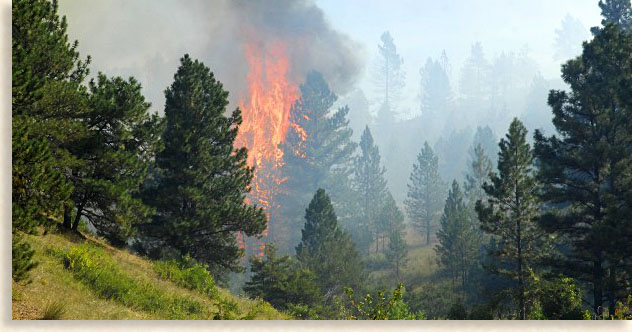
Links of interest
www.SmokeyBear.com - Official Smokey Bear web site
www.predictiveservices.nifc.gov/intelligence/intelligence.htm - Information on each year’s number of fires and number of acres burned
www.firewise.org - Ways to make your home and property fire resistant
